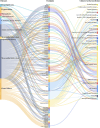Oxylipins as therapeutic indicators of herbal medicines in cardiovascular diseases: a review
- PMID: 39749208
- PMCID: PMC11693728
- DOI: 10.3389/fphar.2024.1454348
Oxylipins as therapeutic indicators of herbal medicines in cardiovascular diseases: a review
Abstract
Globally, cardiovascular diseases (CVDs) remain the leading cause of death, and their prevention and treatment continue to face major challenges. Oxylipins, as novel circulating markers of cardiovascular disease, are crucial mediators linking cardiovascular risk factors such as inflammation and platelet activation, and they play an important role in unraveling cardiovascular pathogenesis and therapeutic mechanisms. Chinese herbal medicine plays an important role in the adjuvant treatment of cardiovascular diseases, which has predominantly focused on the key pathways of classic lipids, inflammation, and oxidative stress to elucidate the therapeutic mechanisms of cardiovascular diseases. However,The regulatory effect of traditional Chinese medicine on oxylipins in cardiovascular diseases remains largely unknown. With the increasing number of recent reports on the regulation of oxylipins by Chinese herbal medicine in cardiovascular diseases, it is necessary to comprehensively elucidate the regulatory role of Chinese herbal medicine in cardiovascular diseases from the perspective of oxylipins. This approach not only benefits further research on the therapeutic targets of Chinese herbal medicine, but also brings new perspectives to the treatment of cardiovascular diseases.
Keywords: cardiovascular disease; herbal medicine; oxylipins; polyunsaturated fatty acids; review.
Copyright © 2024 Li, He, Sun, Li, Li, Jiang, Wang and Wang.
Conflict of interest statement
Author YL was employed by Changchun Sino-Russian Science and Technology Park Co., Ltd. The remaining authors declare that the research was conducted in the absence of any commercial or financial relationships that could be construed as a potential conflict of interest.
Figures


Similar articles
-
Role of oxylipins in cardiovascular diseases.Acta Pharmacol Sin. 2018 Jul;39(7):1142-1154. doi: 10.1038/aps.2018.24. Epub 2018 Jun 7. Acta Pharmacol Sin. 2018. PMID: 29877318 Free PMC article. Review.
-
Crosstalk between adenosine receptors and CYP450-derived oxylipins in the modulation of cardiovascular, including coronary reactive hyperemic response.Pharmacol Ther. 2022 Dec;240:108213. doi: 10.1016/j.pharmthera.2022.108213. Epub 2022 May 18. Pharmacol Ther. 2022. PMID: 35597366 Review.
-
Multidirectional Intervention of Chinese Herbal Medicine in the Prevention and Treatment of Atherosclerosis: From Endothelial Protection to Immunomodulation.Am J Chin Med. 2024;52(4):925-947. doi: 10.1142/S0192415X24500381. Epub 2024 May 27. Am J Chin Med. 2024. PMID: 38798151 Review.
-
Activation of Nrf2/HO-1 signaling: An important molecular mechanism of herbal medicine in the treatment of atherosclerosis via the protection of vascular endothelial cells from oxidative stress.J Adv Res. 2021 Jul 6;34:43-63. doi: 10.1016/j.jare.2021.06.023. eCollection 2021 Dec. J Adv Res. 2021. PMID: 35024180 Free PMC article. Review.
-
Chinese medicine targets cellular autophagy against cardiovascular diseases: research progress and future prospects.Front Cardiovasc Med. 2025 May 26;12:1585407. doi: 10.3389/fcvm.2025.1585407. eCollection 2025. Front Cardiovasc Med. 2025. PMID: 40491718 Free PMC article. Review.
References
Publication types
LinkOut - more resources
Full Text Sources

